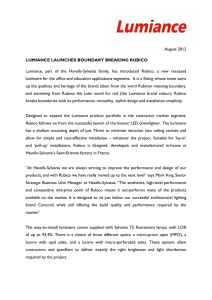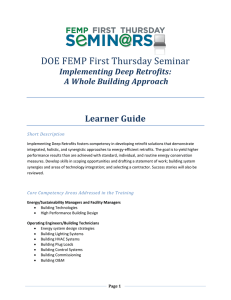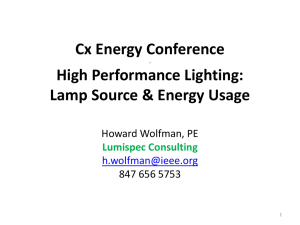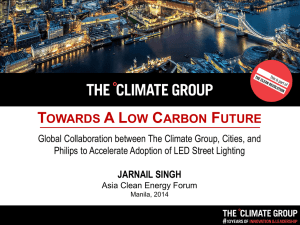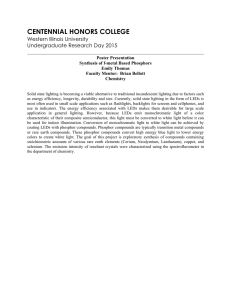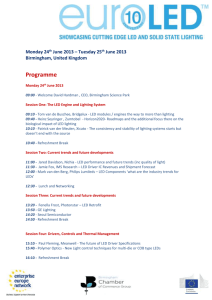FEMP First Thursday Seminar Solid State Lighting: Highlighting Indoor Applications
advertisement
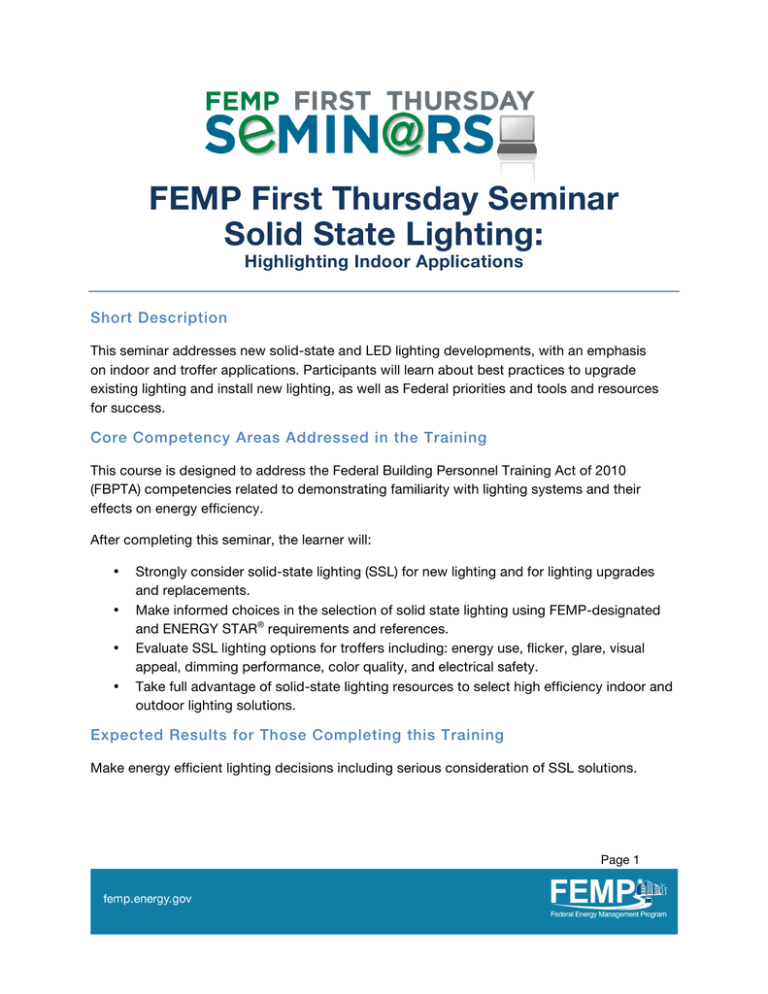
FEMP First Thursday Seminar Solid State Lighting: Highlighting Indoor Applications Short Description This seminar addresses new solid-state and LED lighting developments, with an emphasis on indoor and troffer applications. Participants will learn about best practices to upgrade existing lighting and install new lighting, as well as Federal priorities and tools and resources for success. Core Competency Areas Addressed in the Training This course is designed to address the Federal Building Personnel Training Act of 2010 (FBPTA) competencies related to demonstrating familiarity with lighting systems and their effects on energy efficiency. After completing this seminar, the learner will: • • • • Strongly consider solid-state lighting (SSL) for new lighting and for lighting upgrades and replacements. Make informed choices in the selection of solid state lighting using FEMP-designated and ENERGY STAR® requirements and references. Evaluate SSL lighting options for troffers including: energy use, flicker, glare, visual appeal, dimming performance, color quality, and electrical safety. Take full advantage of solid-state lighting resources to select high efficiency indoor and outdoor lighting solutions. Expected Results for Those Completing this Training Make energy efficient lighting decisions including serious consideration of SSL solutions. Page 1 Lighting Resources "FEMP-designated” Covered Products http://www1.eere.energy.gov/femp/technologies/technologies.html LED Lighting Facts® http://www.lightingfacts.com/ DesignLights Consortium® http://www.designlights.org/ DOE SSL Program http://www1.eere.energy.gov/buildings/ssl/ Better Buildings Alliance (BBA) http://www1.eere.energy.gov/buildings/betterbuildings/bba/bba-index.html Glossary Backlight: Light emitted in the direction of the luminaire. Backlight creates light trespass onto adjacent sites. Backlight is a component of the new TM-15-07 based BUG rating system, which replaces the older cutoff classification system. BUG rating system: System created by IESNA based on TM-15-07 to rate the amount of light emitted from a luminaire in unwanted directions. The methodology represents a comprehensive system that limits lamp lumens to values appropriate for the lighting zone. The BUG rating system replaces the older CALiPER Program: Department of Energy's (DOE) SSL Commercially Available LED Product Evaluation and Reporting (CALiPER) program independently tests and provides unbiased information on the performance of commercially available SSL products. Working in the public interest, the DOE publishes test reports, technical information, and summaries of manufacturer's products and is intended solely for the benefit of the public, in order to help buyers, specifiers, testing laboratories, energy experts and others make informed decisions about SSL products and related technologies. Manufacturers' products are selected randomly for CALiPER program testing. CALiPER's main tests measure and assess (1) energy efficiency of SSL products, as specified in IES LM-79 under luminaire efficacy, via this formula: Total lumens emitted by the luminaire, divided by the total watts drawn by the luminaire's power supply; (2) thermal management and the effect of temperature on lumen depreciation. Page 2 Candela: A measure of luminous intensity, or power emitted by a light source in a particular direction. A common candle emits light with a luminous intensity of roughly one candela. Chromaticity: A measure of color quality as reflected in the CIE (International Commission on Illumination) 1931 color chart, which provides x/y coordinates of reds, greens and blues (RGB). The color of white LEDs, as measured in Kelvin (K), is reflected in a narrow strip at the center of the CIE chart where RGB combinations create various shades of white Color Rendering Index (CRI): A quantitative measure of the ability of a light source to reproduce the colors of illuminated objects accurately when compared to a reference light source, such as an incandescent lamp. Correlated Color Temperature (CCT): The measure used to describe the relative color appearance of a white light source. CCT indicates whether a light source appears more yellow/gold/orange or more blue, in terms of the range of available shades of “white.” CCT is given in kelvins (unit of absolute temperature). Cutoff Luminaire: One of the IESNA luminaire classifications that prescribe light distribution metrics intended to avoid light pollution. A cutoff luminaire is one in which the luminous intensity (in candelas) at or above an angle of 90° above nadir does not numerically exceed 2.5% of the luminous flux (in lumens) of the lamp or lamps in the luminaire, and the luminous intensity (in candelas) at or above a vertical angle of 80° above nadir does not numerically exceed 10% of the luminous flux (in lumens) of the lamp or lamps in the luminaire. Die: A small block of semiconductor material, which is cut from a larger silicon wafer. Diffuser: A device to redirect or scatter the light from a source, primarily by the process of diffuse transmission. Generally categorized as planar and non-planar. Directional: Occurring in only a single direction. This quality of LEDs provides for high levels of efficiency since light is easily directed onto desired surfaces. Driver Efficiency: A measure of luminaire efficiency that focuses on the performance of driver, or power supply, components. Specifically, driver efficiency is the ratio of the power delivered from the driver divided by the power required to operate the driver. Driver: An LED power supply that provides either a constant level of current, or a constant level of voltage. Efficiency: A general term for the amount of useful work per quantity of energy. Page 3 Ballast factor (BF): To improve energy efficiency, Ballast factor (BF) is applied to the rated lumens of the lamps and is a function of the lamp/ballast combination employed. When dimming ballasts are used, the dimmed BF should be used in all calculations. Fixture Efficiency: A measure of luminaire efficiency that focuses on the performance of the combined luminaire, including source efficiency, driver efficiency, and optical efficiency. Fixture efficiency reflects the amount of useful light delivered by the luminaire, divided by the power required to operate it. Foot-Candle: A measure of illuminance or light intensity. A foot-candle reflects the amount of illumination the inside surface of a 1-foot radius sphere receives from a point source of one candela in the center of the sphere. A foot-candle is also equal to one lumen per square foot. Fully Rated Life: An achievement by a device or system that provides useful service for as long as the device or system manufacturer projects. For example, white LEDs are commonly marketed with 50,000-hour fully rated lives, where the end of life is defined by the point at which the LED fails to deliver at least 70% of initial lumen output. Gallium Nitride (GaN): A type of semiconductor material used in manufacturing blue LEDs and other electronic devices. General illumination: A term used to distinguish between lighting that illuminates tasks, spaces, or objects from lighting used in indicator or purely decorative applications. In most cases, general illumination is provided by white light sources, including incandescent, fluorescent, high-intensity discharge sources, and white LEDs. Lighting used for indication or decoration is often monochromatic, as in traffic lights, exit signs, vehicle brake lights, signage, and holiday lights. Glare: Consists primarily of light emitted at high angles emitted from the front and back of the luminaire, which may interfere with ground-level pedestrians and motorists. Glare is a component of the new TM-15-07 based BUG rating system. Heat Dissipation: The intentional transition of thermal energy from a hotter object (such as a sensitive electronic device) to a cooler object. Heat dissipation is achieved with LEDs primarily by mounting them on heat sinks made on high-quality aluminum and other alloys. Heat Sink: An object that absorbs and dissipates heat from another object using thermal contact (either direct or radiant). High Bay: A lighting fixture most often used in warehouses and high ceiling spaces like transportation bays Page 4 High Power LEDs: LEDs designed to operate at several hundred milliamps and a watt or more of power. Since these devices create substantial heat, which would destroy the unit if special steps were not taken, specialized heat dissipation technologies must be employed. Indium Gallium Nitride (InGaN): A type of semiconductor material used in manufacturing blue LEDs and other electronic devices. Illuminating Engineering Society of North America (IESNA): A non-profit organization that “seeks to improve the lighted environment by bringing together those with lighting knowledge and by translating that knowledge into actions that benefit the public L70: An abbreviation for 70% of initial lumens levels delivered from an LED, which is a common definition of the useful life of an LED. LED Array: A predetermined pattern of a number of LEDs mounted on a printed circuit board (PCB) or other surface, which is capable of producing light when powered. LED Efficiency: A measure of the light output of an LED device, generally measured in lumens, divided by the power, generally measured in watts, required to operated the device. This relationship, lumens per watt, is a key measure of LED performance. LED Junction Temperature (TJ ): The temperature of the P/N junction inside the LED. Although TJ cannot be directly measured, there are a number of widely used, reliable methods of accurately estimating TJ. Light Emitting Diode (LED): An electronic light source derived from a semiconductor diode possessing unidirectional electric current properties—in other words, diodes are one-way switches. When a voltage is applied in the forward direction, electrons from one side of the P/N junction recombine with holes on the other side of the junction, and energy is released in the form of light. Light-emitting diodes (LEDs) are based on inorganic (non-carbon based) materials. LM-79: Popular name for an LED measurement standard, the full title of which is IESNA LM79-08, Approved Method for the Electrical and Photometric Measurements of Solid-State Lighting Products. This standard provides guidelines to photometric labs for the proper and repeatable measurement of LED lighting systems LM-80: Popular name for an LED measurement standard, the full title of which is LM-80-08, Approved Method for Measuring Lumen Maintenance of LED Light Sources. This standard provides guidelines to LED manufacturers for measuring lumen maintenance, or the level of light output maintained over predetermined time periods. Page 5 Lumens Per Watt (LPW): The ratio of light produced by an LED device, measured in lumens, divided by the power, measured in watts, required to operated the device. LPW is a key measure of LED performance. Luminaire: A lighting fixture complete with lamp, optical components used to direct light, housing, and power supply (e.g., a fluorescent ballast or LED driver). Luminous efficacy: is the most commonly used measure of the energy efficiency of a light source. It is stated in lumens per watt (lm/W), indicating the amount of light a light source produces for each watt of electricity consumed. For white high-brightness LEDs, luminous efficacy published by LED manufacturers typically refers to the LED chip only, and doesn’t include driver losses. Lux: A metric measure of illuminance, or the apparent intensity of light hitting or passing through a surface. Omnidirectional: Occurring in many or all directions, such as traditional HID and other lamps. This quality of traditional lamps limits their efficiency due to the challenges inherent in directing the light produced onto desired surfaces. Optical Efficiency: A measure of luminaire efficiency that focuses on the performance of optical components. Specifically, optical efficiency is the ratio of lighting delivered by a luminaire to the light produced by the lamps. Organic light-emitting diodes (OLEDs): are based on organic (carbon based) materials. In contrast to LEDs, which are small point sources, OLEDs are made in sheets that provide a diffuse area light source. OLED technology is developing rapidly and is increasingly used in display applications such as cell phones and PDA screens. However, OLEDs are still some years away from becoming a practical general illumination source. Additional advancements are needed in light output, color, efficiency, cost, and lifetime. P/N Junction: The border region in a semiconductor device formed by placing P-type (or materials carrying a positive charge) and N-type (or materials carrying a positive charge) semiconductor materials together in close proximity. It is the location in an LED where light is created, as well as the location inside the LED where heat is created Parabolic louvers: Control luminance precisely, they consist of multiple cells with parabolic reflectors, and a specular or semi-specular finish. The cells range in size from ½ in. X ½ in. to 1 ft. X 1 ft. Phosphors: A substance that exhibits phosphorescence, which is the process of glowing occurring after exposure to energized particles. Many white LEDs are produced by combining Page 6 GaN or InGaN LEDs, which produce blue light, with YAG (yttrium aluminum garnet) phosphors. See white phosphor LED. Phosphor conversion: is a method used to generate white light with LEDs. A blue or nearultraviolet LED is coated with a yellow or multi-chromatic phosphor, resulting in white light. Printed Circuit Board (PCB): A material used to mechanically support and electrically connect electronic components using conductive pathways, or traces, etched from copper sheets laminated onto a non-conductive substrate. Common types include FR-4 (Flame Retardant 4) and metal-core PCBs. The latter are commonly used with LEDs to aid in thermal management. Prismatic lenses: Incorporate a pattern of small prisms or other refractive elements to reduce the luminance of the luminaire and inhibit direct glare. Solid State: Electronic components and systems based on the use of semiconductors rather than vacuum tubes. Common types of solid state components include integrated circuits, liquid-crystal displays, and LEDs. Solid-state lighting (SSL): This technology uses semi-conducting materials to convert electricity into light. SSL is an umbrella term encompassing both light-emitting diodes (LEDs) and organic light emitting diodes (OLEDs). Source Efficiency: A measure of luminaire efficiency that focuses on the performance of lamps. The source efficiency of LEDs is currently about equal with many fluorescent and HID sources, but the directional nature of light produced from LEDs delivers substantially higher fixture (or system) efficiency than traditional sources. T8: A type of fluorescent lamp. The “T” means it is tubular in shape and the “8” means the diameter is eight-eighths of an inch, or 1 inch. A T12 lamp is twelve-eighths of an inch, or 1.5 inches thick. T8 lamps have a better CRI and are more efficient than T12 lamps. Thermal Efficiency: A measure of luminaire efficiency that focuses on the ability of the luminaire system to transfer heat from sensitive components, such as LEDs, to the outside environment. High levels of thermal efficiency are made possibly through the use of highquality components (such as LEDs with low thermal resistance) and materials (such as aluminum alloys with low thermal resistance), as well as intelligent product designs. TM-15-07: A Rating system developed by IESNA which replaces the older IES cutoff classification system for controlling light emitted in unwanted regions surrounding a luminaire. TM-21: Lumen Depreciation Lifetime Estimation Method for LED Light Sources. TM-21 will provide a method for determining an LED luminaire or integral replacement lamp's expected operating life, based on initial performance data collected per IES-LM-80. Page 7 Troffer: An inverted trough serving as a support and reflector usually for a fluorescent or LED lighting unit. It is typically rectangular or square in shape, as in a 2-foot by 4-foot luminaire. UL1598/8750A: UL standard for Luminaires - specifies the minimum safety requirements for luminaires. UL1310/8750: UL standard for Class 2 Power Units - specifies the minimum safety requirements for Class 2 power supplies. (As defined by the National Fire Protection Association (NFPA), 70-2005) UL-8750: Underwriters Laboratory (UL) has developed this safety standard for "Light Emitting Diode (LED) Light Sources for Use in Lighting Products.” White Light: Comprises light from all the frequency bands in the visible spectral range. Hence, it is a combination of red, orange, yellow, green, blue, indigo, and violet. Uplight: Light emitted from the luminaire directly into the sky, which causes artificial sky glow and generally represents wasted energy. Uplight is a component of the new TM-15-07based BUG rating system, which replaces the older cutoff classification system. Useful Life: The length of time an asset or device can be used without major refurbishing. In lighting, the useful life of lamps is typically stated at 70% of initial lumens since it is difficult to perceive this reduction in light output. Voltage Electrical Potential Difference: Commonly expressed as (VA − VB). Voltage is conceptualized as the electrical driving force that drives a conventional electric current in the direction A to B. LED voltage is determined by the physical structure of the semiconductor material, and the level of light produced by the LED is determined largely by the level of current flowing to the LEDs. White Phosphor LEDs: Combinations of InGaN (indium gallium nitride) semiconductor material, which produces blue light, and YAG (yttrium aluminum garnet) phosphors, which creates white light. Other LED systems deliver white light by combining red, green and blue (RGB). Page 8
